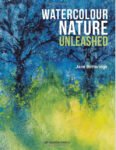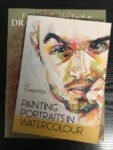I wasn’t expecting to be doing a book review today. The only job I had on my list was to update my swatch reference sketchbook with notes on my newly discovered favourite triple glaze combinations. And, while waiting for the first layers of colour to dry, I picked up this book and started reading. And I just kept on reading, just having to interrupt myself every now and then to swatch more paint. So, now that I’ve finished it and made some notes, here’s my review.
This is a 112 page hardback, quite a hefty feeling book for the price. The portraits are all of Japanese women or, in some places, kids and the artist is Japanese but otherwise I don’t know what constitutes a “Japanese style” portrait. So not the most helpful name ever for a book but let’s move on. This is really just a book on watercolour portraits, quite realistically coloured watercolour portraits in particular. I’m new enough to be able to imagine looking at this book as a complete beginner, as well as through more experienced eyes, and I’ll try to reflect this in my comments.
We have about 20 pages of introduction, 20 pages on sketching, 30 pages on painting the face and hair, 20 pages on clothing and backgrounds and 20 pages of summing up. The contents page, as well as dividing the book into five chapters, subdivides it into 48 “lessons”, which gives this book the feel of a How And Why Wonder Book (remember them?) and is a good way to ensure that the author always has something to say.
Let’s go through chapter by chapter. We have the usual stuff on gear and some thoughts on what direction to paint the subject from. Hiroko recommends we use transparent paints, which I support big time, but then she specifically recommends cadmium red and cadmium yellow, which are both opaque and both of which she uses extensively. That’s a weird start. You always need to have your brain engaged when reading books and be ready to challenge the author in your head. Having said that, I’ve seen those two cadmiums recommended elsewhere for flesh tones (by Charles Reid).
Then we move on to the initial sketch. I found it quite refreshing that the author’s emphasis here was on measuring distances and angles and on thinking about all the underlying 3D shapes. In particular I like how Hiroko didn’t give us a big long boring list of rules of thumb about sizes and positions of features of the face. Just two or three rules and that was all: after that it’s down to observation. It’s more “make sure you put the ears in the right place” than “this is where the ears go”. Most of this chapter follows a single demonstration.
In the third chapter, the demonstration continues but now we’re painting. Most of this chapter is a continuation of the demonstration in the previous chapter with the odd interesting tip thrown in. The demonstration is generally quite prescriptive but there’s the odd place wherever author says she only did something because of the way her own painting was developing, so it’s not a demonstration to follow blindly. And, actually, with things like eyes being really complicated, I found it useful to follow a demonstration that chopped the work up into lots of tiny tasks – it made things much easier to follow. But the highlight of the chapter is page 48. This page alone justifies the price of the whole book, so we’re already looking at at least three palettes. Spoilers! Anyway, page 48 has a drawing of a head with four sets of colour coded areas: (i) lit up planes to highlight, (ii) shadowed planes angled away from the light, (iii) shadowed planes that pick up a bit of reflected light, (iv) deep shadows on areas blocked from the light. Like I say, an amazing page.
Then we have the chapter on clothing and backgrounds. The clothing bit is really about painting patterned clothing rather than a detailed analysis of drapery and folds but there’s an example of a white lacy top with flesh tones showing through from underneath that’s jaw dropping. The stuff on backgrounds is interesting too. Should they be detailed or empty? Light or dark? The answers are all here.
And finally we have the closing pages. A little bit of advice on painting kids and two more demonstrations with far fewer steps than the one from earlier in the book and, to be honest, without many new lessons for us.
So there we are. Even though my own portraits are far more adventurously coloured than those in here, there were still lessons in there for me, which was good. But I also need to view this through beginners’ eyes, and I have to say this would make a great introduction to (realistically coloured) watercolour portraits: it smacks
David Thomas out of the park. I personally still prefer the
Maughan/
Chaderton combination but that may be more down to my colourful style. Even though I learned something from this book, I felt as if it was aimed at beginners (beginners at portraits anyway, not necessarily complete watercolour beginners) because it didn’t ever seem to take that extra step into advanced techniques. That’s why this book doesn’t get five palettes but it’s still getting the four. It’s an excellent book and a long overdue addition to the bookshop shelves.
🎨🎨🎨🎨
Oh, and while I remember, I started thinking about what might be a good book to supplement this one or to just read a few months later. And you know what? I’d go for a Charles Reid book. Either
this one or, better still,
this one. Both would take the reader’s artwork a step forward from “Japanese style” by introducing them to contour drawing, the idea of including a blue within flesh tone mixes and some ideas for loosening up brushstrokes around facial features. Or is that me pushing too far? Caveat emptor.









Leave a Reply